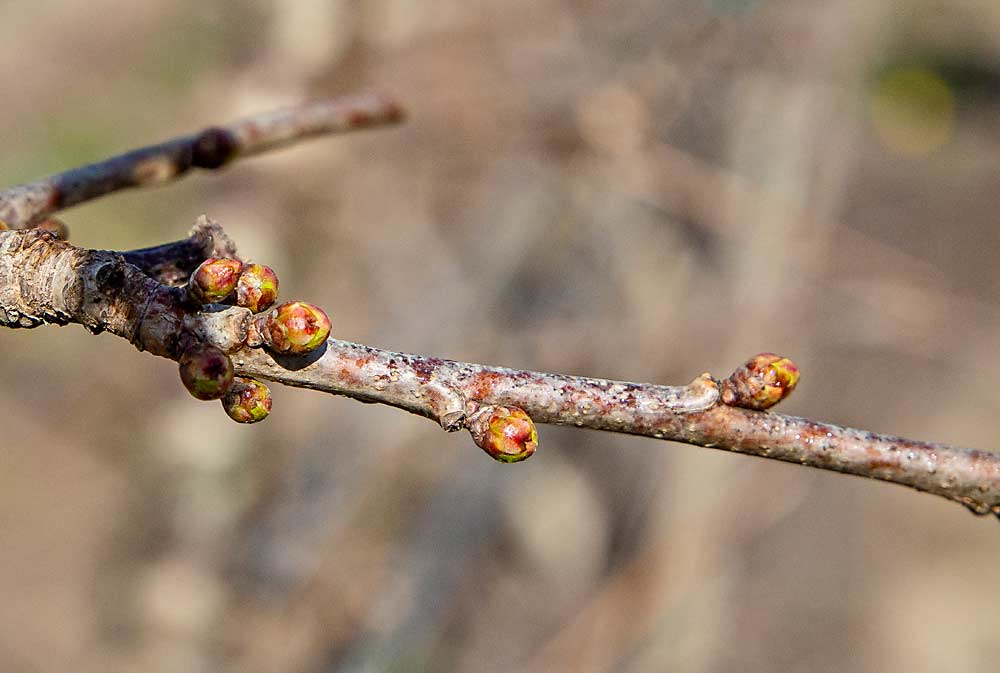
Washington State University researchers believe there is commercial potential for their cellulose-derived fruit bud insulation, and they are aiming to get it to growers next year.
Several years of data have convinced them that plant-based dispersions, usually called cellulose nanocrystals and nanofibrils, are effective, but they have one more year of trials planned before commercialization.
“We know it works; we want to try it large-scale,” said Matt Whiting, a horticulture professor at WSU’s Irrigated Agriculture Research and Extension Center.
Whiting and three colleagues — Qin Zhang, Changki Mo and Xiao Zhang — have formed an LLC under the name Pomona Technologies, named for the Roman goddess of fruit and orchards. They have begun negotiating with WSU to license the yet-unnamed product, which sprays on as a milky substance that coats fruit buds to protect them from cold. The scientists are seeking a utility patent and a registration label from the U.S. government. They aim to hold large trials this year and sell the product commercially in 2022.
Goals for the startup are modest and grandiose at the same time. They aim to use a well-known plant byproduct to solve agriculture’s oldest problem — the weather.
The spray-on substance consists of natural polymers derived from cellulose, the main ingredient in the longevity and strength of trees. Nothing man-made compares. Researchers test its use in everything from cosmetics to electronics to artificial blood vessels.
Xiao Zhang, a professor of chemical engineering and bioengineering at WSU Tri-Cities, was involved with some of those application attempts in his previous forestry career. He believes frost control could be the commercial breakthrough.
“It’s eye-opening to me,” he said.
Whiting and Zhang stumbled upon the idea in casual conversation. Whiting was unfamiliar with the substance. Zhang didn’t even know frost was a problem in tree fruit.
The cellulose nanomaterials usually are a byproduct of wood pulp, but wheat straw, grasses and even cotton work. But they are not a waste product. The extraction process is arduous and technical, so don’t expect orchardists to start home-brewing their own sprays from pruning debris, Zhang said.
The team at WSU currently purchases nanomaterial from suppliers in Europe and Eastern North America, though they are looking for closer sources. They recently submitted a proposal to use hemp. They import the substance as paste or freeze-dried crystals and use an oversized blender to mix in proprietary additives. They’ve settled on an active ingredient concentration between 1 percent and 3 percent. Any less, and efficacy fizzles. Any more, and the gel gums up the spray valves.
They have not determined a potential price for the commercial product, Whiting said.

Research chops
In trials last year, the dispersion seemed to dramatically decrease bud mortality during natural freezes. In a Sunnyside, Washington, Early Robin cherry block, only 2.9 percent of buds treated with the dispersion died, compared to 13.6 percent mortality in the control buds. Down the highway, in a Pasco Early Robin orchard, dispersion-treated buds had a 16.7 percent mortality rate, compared to 30.5 percent for untreated buds.
What’s more, the Pasco block yielded 33.9 pounds per tree, more than double the control’s 16.3 pounds. Whiting’s team did not have yield data from the Sunnyside orchard.
Results from 2018 and 2019 trials in a freeze chamber — there were no natural freeze events those years — show varying degrees of bud protection, just as they did from the natural freezes of 2020.
This year, they aim to collect results from a few hundred acres of treatments, Whiting said.

The research was funded by the U.S. Department of Agriculture’s National Institute of Food and Agriculture, the Washington Tree Fruit Research Commission, the WSU Office of Research and the Washington Research Foundation, while a WSU Commercialization Gap Fund grant helped pay for some of the business steps.
Several growers in a frosty section of the U.S. Mid-Atlantic region are interested, said Bill Mackintosh, a diversified direct-market fruit grower in Virginia.
After hearing Whiting’s virtual presentation at the Great Lakes EXPO in December, Mackintosh and some neighbors tried to order enough to cover 5,000 acres. The WSU team had nowhere near that supply this year, Whiting said, but agreed to provide enough for a few trials.
Mackintosh owns a U-pick farm with stone fruit, cherries, pears, apples and berries and an on-site store with ice cream and baked goods that caters to the Washington, D.C., urban center, about an hour to the east. But he also consults for large growers, interested in treating hundreds of acres at a time, he said.
The area sits in a “frost pocket” where growers use wind machines, sprinklers and propane heaters, mostly on early blooming stone fruits, Mackintosh said. But not every grower has all those tools, either because they rent ground or lack water pressure for sprinklers. In the spring of 2020, some lost half their apple production to a late freeze.
An option such as plant-based dispersions would enable growers to protect apples and pears, as well as stone fruit, and insulate businesses both horticulturally and economically.
“If we lose a crop to frost, the customers don’t come, and we not only lose fruit sales but our value-added items, as well,” Mackintosh said. “To survive, we must have fruit to pick. That’s what brings our customers to the farm.” •
—by Ross Courtney







Leave A Comment